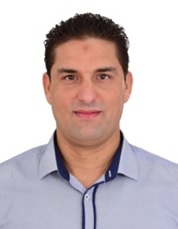Latest Articles
Original Research Article
ABSTRACT
Background: Postoperative infections in orthopedic implants remain a challenging complication, contributing to morbidity, prolonged hospitalization, and healthcare costs in low-resource settings. This study aimed to determine the epidemiological profile, bacterial isolates, antibiotic susceptibility patterns, and treatment outcomes of postoperative infections following orthopedic implant surgeries in Bangladesh. Methods: This prospective cohort study was conducted at the District Sadar Hospital, Rajbari, Bangladesh, from May 2023 to April 2024. A total of 280 patients with confirmed postoperative implant infections were analyzed. Demographic data, infection timing, bacterial isolates, antibiotic sensitivity, and treatment outcomes were also recorded. Data were analyzed using SPSS version 25.0. Results: The mean age of the patients was 45.6 ± 15.2 years, with 70% males. Early onset infection occurred in 44.3% of the cases. Staphylococcus aureus (38.6%) was the predominant isolate, and it showed high sensitivity to vancomycin and linezolid. Debridement with implant retention achieved infection control in 81.2% of cases, whereas implant removal and revision had the best eradication rates (87%). Conclusion: Postoperative infections in orthopedic implants are primarily early onset and dominated by gram-positive cocci. Effective surgical debridement combined with appropriate antibiotics remains the cornerstone of treatment. Enhanced infection control and antibiotic stewardship are crucial for reducing the incidence and resistance patterns.
Original Research Article
ABSTRACT
Background: Osteoporosis is a major public health concern among postmenopausal women, leading to increased fracture risk and morbidity. Bone mineral density (BMD) assessment is the most reliable method for early detection, with Dual-Energy X-ray Absorptiometry (DEXA) considered the gold standard. Identifying factors associated with reduced BMD is essential for timely preventive interventions, especially in populations with limited healthcare access. Methods: This cross-sectional study was conducted in the Department of Orthopedics, District Sadar Hospital, Rajbari, Bangladesh, from February 2020 to January 2022. A total of 300 postmenopausal women aged ≥45 years, with spontaneous cessation of menstruation for at least one year, were included through purposive sampling. Demographic and clinical data were collected and BMD was measured at the lumbar spine and femoral neck using DEXA. Data were analyzed using SPSS version 25, with Chi-square tests to assess associations between BMD and age, duration since menopause and body mass index (BMI). Results: Among 300 participants, the mean age was 58.6 ± 7.4 years and the mean duration since menopause was 9.2 ± 5.8 years. Osteopenia was most prevalent (45.7%), followed by normal BMD (28.3%) and osteoporosis (26%). Osteoporosis prevalence increased with age (from 9.2% in 45–50 years to 52.9% in >65 years, p < 0.001) and longer menopausal duration (10.4% in <5 years to 40.7% in >15 years, p = 0.002). Underweight women had the highest prevalence of osteoporosis (48.8%), while overweight and obese women had higher rates of normal BMD (38.9% and 38.5%, respectively, p = 0.015). Conclusion: Reduced BMD is highly prevalent among postmenopausal women in rural Bangladesh. Advancing age, longer menopausal duration and lower BMI are significant risk factors, highlighting the need for early screening and preventive strategies.
Original Research Article
ABSTRACT
Background: Carpal Tunnel Syndrome (CTS) is a compressive neuropathy of the median nerve that commonly affects manual laborers, including traditional ikat weavers. Repetitive hand movements and prolonged wrist flexion contribute significantly to CTS occurrence. Objective: To analyze the relationship between working period and Carpal Tunnel Syndrome complaints among ikat weaving workers in Bomari and Boradho Villages, Ngada Regency. Methods: A cross-sectional analytic study was conducted from June to August 2024 among 50 ikat weaving workers meeting inclusion and exclusion criteria. Data collection used structured questionnaires and the Boston Carpal Tunnel Questionnaire (BCTQ). The Chi-Square test with a significance level of p < 0.05 was applied to determine the relationship between working period and CTS complaints. Results: Most respondents (66%) had mild to moderate CTS complaints. A statistically significant relationship was found between the working period and CTS complaints (p = 0.012). Workers with more than 10 years of weaving experience had a higher likelihood of developing CTS symptoms. Conclusion: There is a significant relationship between working period and CTS complaints among ikat weaving workers. Early ergonomic interventions and preventive education are essential to reduce CTS risk in traditional weaving communities.
Original Research Article
ABSTRACT
Background: Operating theatre efficiency and utilization patterns in secondary healthcare centers across sub-Saharan Africa remain poorly documented despite their critical role in surgical care delivery. Understanding these patterns is essential for optimizing resource allocation and improving surgical outcomes in resource-limited settings. Objective: To analyze operating theatre utilization patterns, case complexity, resource optimization strategies, and perioperative outcomes in orthopedic surgery at a Nigerian secondary healthcare center, comparing findings with international benchmarks. Methods: A retrospective audit of 62 consecutive orthopedic surgical cases at Adeoyo State Hospital was performed conducted over 36 months from June 2022 to June 2025. Data analyzed included surgical procedures, case complexity, duration, blood loss, transfusion requirements, and perioperative outcomes. Theatre efficiency metrics were calculated, and statistical analysis using SPSS version 21. Results: ORIF procedures dominated (29.0%), followed by hemiarthroplasty (22.6%) and amputations (12.9%). Mean case duration was 3.2±1.4 hours with 51.6% classified as moderate complexity. Blood transfusion was required in 41.9% of cases (mean 1.2±0.4 units). Theatre utilization averaged 65.4% with 70% emergency procedures. Overall complication rate was 6.5% with no perioperative mortality. Mean length of stay was 12.8±6.7 days. Conclusion: Secondary care orthopedic theatres demonstrate efficient utilization despite resource constraints, successfully handling complex cases with acceptable outcomes. However, high transfusion rates and extended hospital stays suggest opportunities for optimization through enhanced perioperative protocols and improved resource planning.
Original Research Article
ABSTRACT
Background: Traditional bone setters (TBS) remain integral to fracture care in Nigeria, often serving as the first point of contact for injured patients. Understanding the healthcare journey from traditional to modern medicine is crucial for improving orthopedic outcomes and reducing complications in resource-limited settings. Objective: To analyze healthcare-seeking patterns, treatment delays, complications, and outcomes among fracture patients who visited traditional bone setters before presenting to a Nigerian secondary healthcare center. Methods: A retrospective cross-sectional study was conducted at Ring Road State Hospital, Ibadan, over 36 months from June 2022 to June 2025. Data from 62 consecutive orthopaedic patients were analyzed, comparing outcomes between TBS users and non-users. Clinical monitoring included complications, amputation rates, and final outcomes using standardized assessment protocols. Statistical analysis was performed using SPSS version 21. Results: Overall, 45.2% (28/62) of patients visited TBS before hospital presentation. TBS users had significantly higher complication rates (25.0% vs 8.8%, p<0.05, RR=2.8, 95%CI: 1.2-6.7), amputation rates (21.4% vs 5.9%, p<0.05, RR=3.6, 95%CI: 1.2-11.0), and longer delays to definitive care (median 3 weeks vs 3 days). Chronic osteomyelitis was 3.6 times more common in TBS users (21.4% vs 5.9%). Case neglect occurred in 35.5% of patients, with 77% being TBS users. Conclusion: Traditional bone setter utilization significantly increases the risk of complications, amputations, and treatment delays in fracture patients. The study demonstrates urgent need for integrated healthcare models and community education to bridge the gap between traditional and modern orthopedic care in Nigeria.
Original Research Article
ABSTRACT
Background: Laminectomy and discectomy are established surgical treatments for Prolapsed intervertebral disc (PIVD), aiming to decompress neural structures. However, routine addition of pedicle screw fixation in the absence of overt spinal instability remains a subject of ongoing debate. This study aimed to evaluate and compare functional outcomes in patients presenting with PIVD treated by laminectomy and discectomy without or with concomitant pedicle screw fixation. Materials and Methods: This comparative study was conducted in the Department of Orthopaedics, for a period of 18 months, which included 96 patients divided into two treatment groups of laminectomy and discectomy: (a) Without pedicle screw fixation, and (b) With pedicle screw fixation. Patients were followed up at 1, 3, and 6 months for post-operative functional outcome of patients, as assessed by the VAS scores for low back pain and leg pain, Oswestry Low Back Pain Disability Questionnaire, JOA scores, Roland-Morris Low Back Pain and Disability Questionnaire, and muscle power grading. Results: There was statistically significant improvement in the NPRS scores from baseline to 6-month follow-up period in both the study groups (p<0.001). Additionally, there was improvement in other outcome parameters in both study groups from pre-operative to 6-month follow-up, but the difference was not statistically significant (p>0.05). Conclusion: The study concluded that routine application of pedicle screw fixation may not be essential for this specific patient demographic, potentially enabling a less invasive surgical approach.
Original Research Article
Management of Comminuted Distal Femur Fractures Using Locked Condylar Plates
Charif M1, Antar A, Aguenaou O, Fekhaoui M.R, Mekkaoui M.J, Bouffetal M, Bassir R.A, Kharmaz M, Lamrani M.O
EAS J Orthop Physiother, 2025; 7(5): 125-127
https://doi.org/10.36349/easjop.2025.v07i05.001
Abstract
PDF
FULL TEXT
E-PUB
506 Downloads | Sept. 2, 2025
ABSTRACT
Comminuted fractures of the distal femur are a therapeutic challenge due to their anatomical complexity and frequent association with bone fragility, especially in elderly patients. The introduction of locked condylar plates has brought significant progress in the surgical management of these lesions. These plates offer superior angular stability, particularly useful in the presence of multiple fragments or osteoporosis. This retrospective study was conducted at the Ibn Sina University Hospital in Rabat, including 32 patients operated for comminuted distal femur fractures (AO/OTA types C2 and C3) between January 2018 and December 2023. All cases were treated using locked condylar plates, with early rehabilitation and a minimum follow-up of 12 months. Bone union was achieved on average at 14.6 weeks. The mean functional outcome (Knee Society Score) at 12 months was 82.7. Complications were rare: two cases of stiffness requiring arthrolysis, one case of superficial infection managed medically, and no cases of nonunion. These results confirm the efficacy and reliability of locked condylar plates in stabilizing complex comminuted fractures of the distal femur.


















